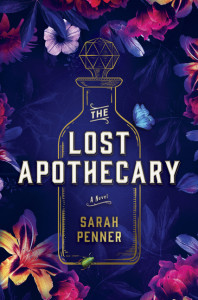In a back alley in 1791 London, a wooden door opens to what appears to be a storeroom. However, those in the know are aware that behind a hidden door lies Nella Clavinger’s apothecary shop. Like her mother before her, she caters only to women and dispenses powders and salves to ease their pains. However, unlike her mother—and this is why her shop is secret—she also sells poisons to women who need to get rid of a man who is mistreating them.
Nella’s work with poisons has prematurely aged her, and she suffers pain and weakness. One day she is surprised when it is not a woman who arrives at the appointed time to collect a poison, but a 12-year-old girl, Eliza Fanning, a maid picking it up for her mistress. Eliza is fascinated by Nella and begs to be taught her skills. Nella refuses, but Eliza’s presence still has catastrophic consequences.
There’s more: This book has a dual timeline.
In present-day London Caroline Parcewell is visiting from Ohio. Although this long-planned trip was to celebrate their tenth wedding anniversary, she has left her husband at home, after discovering that he has been having an affair.
As she wanders disconsolately around the city, she stumbles on a mudlarking tour, mudlarks being the name for people in earlier centuries who dug in the edges of the Thames looking for anything they can sell. She finds a mysterious vial and eventually suspects she’s on the trail of eighteenth-century London’s “apothecary murderer.”
The two stories intertwine, both speaking of women trying to control their own destinies. Nella keeps a register, the one started by her mother, noting the name of each customer, the date, and what they purchased. She knows that women like her—not wealthy, not royalty—are not recorded or remembered. So her register is one small way to recognise women who would otherwise be forgotten.
Even as Nella tries to find a way out of the troubles that come upon her, Caroline looks back over her marriage, assessing where she has abandoned her own dreams and debating whether she can continue with the marriage.
There’s a lot of suspense, with as many twists and turns as a back alley in eighteenth-century London. As always, after my first immersive read, I examined some technical aspects of the book. In this case, I was interested in how the two timelines bounced off each other, sometimes reflecting, sometimes diverging. I was also interested in the way information was gradually revealed, heightening the suspense. I have a few minor quibbles, but overall the book was a good read and a fine way to while away a rainy afternoon.
Can you recommend a book with a dual timeline?
